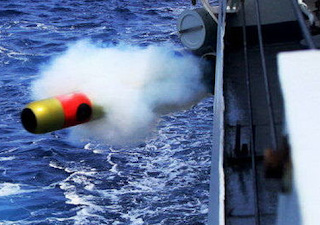China’s navy recently conducted a test of a new high-speed maneuvering torpedo that poses a threat to U.S. ships and submarines.
Defense officials said the new torpedo is the latest example of what the Pentagon calls Beijing’s anti-access, area-denial, or AA/AD, high-tech weaponry.
Other new weapons include China’s recently deployed anti-ship ballistic missile, the DF-21D, which is designed to sink U.S. aircraft carriers far from China’s shores.
China’s military showcased last month another high-tech weapon designed to target Navy ships and submarines. U.S. submarines are considered one of the U.S. military’s most important counter weapons to the AA/AD threat.
 |
| China's New High-Speed Precision-Guided Torpedo |
The torpedo test was disclosed on a Chinese blog, a frequent outlet for official leaks of new weapons systems in the Chinese arsenal.
The blog Tencent, one of China’s largest online outlets, revealed Oct. 15 that China’s navy conducted an underwater test launch of a new precision-guided, maneuvering torpedo in the South China Sea.
China has been blamed for growing tensions in the South China Sea region over the past several months by asserting claim to nearly 90 percent of the waters, bringing it into potential conflict with Vietnam and Philippines and raising concerns in Indonesia and Malaysia about growing Chinese hegemony.
The blog post included a series of photos revealing what was described as a new type of high-speed “intelligent” torpedo that sank a 1,000-ton target ship in the test firing.
“The new-type torpedo that was launched from a long distance and at a great depth nimbly skirted around the jamming ‘acoustic decoy’ and struck right in the middle of the 1,000-ton-plus target ship, sinking it with a loud boom,” the posting reported.
The report said the new torpedo represents a “leap” for the People’s Liberation Army Navy to “the front ranks of the world.”
Rick Fisher, a China military affairs expert, said the new torpedo signals a shift in China’s past practice of relying on Soviet-Russian and stolen American technology to build torpedoes.
China also is said to be using Russian underwater warfare know-how to build a torpedo-killing anti-torpedo. The killer torpedoes are launched against incoming underwater torpedoes that, like the reported new Chinese weapon, are immune to U.S. electronic countermeasures.
“If China is developing torpedoes that are able to out-fox towed decoys like the U.S. Nixie system, then it becomes more urgent that the U.S. Navy deploy its own ‘anti-torpedo’ torpedo,” said Fisher, senior fellow at the International Assessment and Strategy Center.
The Nixie system is a ship-towed electronic decoy that simulates the signature of a ship in the water. It is intended to divert homing torpedoes from hitting ships carrying the decoy.
“The U.S. has had such a [anti-torpedo] system under development for many years, but it now needs to be preserved in time of tighter budgets, and even accelerated,” Fisher said.
The designation for the new Chinese torpedo and the type of submarine or ship it was fired from were not identified. One photo showed the torpedo fired from a ship. Other photos showed it being loaded on a submarine.
However, the test was conducted near the South China Sea’s Hainan Island. A tunnel entrance to a coastal submarine base on the island was photographed several years ago by satellites.
The base is home to China’s new Type 094 attack submarines and the torpedo test was likely fired from the nuclear powered sub.
The posting said China’s torpedo technology in the past was a “weak area” of military development. But armed with the new “all digital” torpedo, attack submarines will be able to “fight winning battles.”
According to the blog, the torpedo was fired at a preset course “like a kite that was tethered to the submarine, as it was still receiving real-time instructions from the submarine.”
Then at a certain point, the torpedo “guidance device” was activated and the torpedo searched for its target. Within minutes it “automatically adjusted the attack depth and started to charge toward the target ship at a greater speed, successfully piercing the target!” the report said.
The torpedo pierced the target four times before its high-explosive warhead exploded, sinking the ship.
A draft congressional report on China’s military to be released in its final form later this month said China is rapidly building up its naval forces, especially submarines. According to the Office of Naval Intelligence, China by 2020 will have between 59 and 64 diesel-electric submarines, between six and nine nuclear attack submarines, and between four and five ballistic missile submarines.
The Chinese navy is currently building at least seven classes of new submarines and warships, more than any other nation in the world except the United States.
“The PLA Navy’s growing inventory of modern nuclear and conventional submarines will significantly enhance China’s ability to strike opposing surface ships throughout the Western Pacific and to protect its future sea-based nuclear deterrent patrollers and aircraft carrier task groups,” the draft report of the U.S.-China Economic and Security Review Commission stated.
Overall, the Chinese buildup “presents significant challenges to U.S. security interests in Asia” and is on track to “alter the security balance in Asia over the next five to 10 years, challenging decades of U.S. military preeminence.”
“First and foremost, major elements of this program—such as the DF-21D antiship ballistic missile and increasing numbers of advanced submarines armed with antiship cruise missiles—are designed to restrict U.S. freedom of action throughout the Western Pacific,” the report said.
“As the PLA’s anti-access/area denial capabilities mature, the costs and risks to the United States for intervention in a potential regional conflict involving China will increase.”




No comments:
Post a Comment